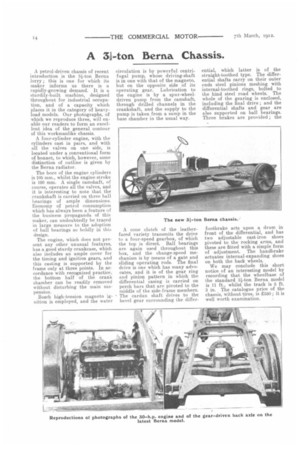A 31-ton Berna Chassis.
Page 14

If you've noticed an error in this article please click here to report it so we can fix it.
A petrol-driven chassis of recent introduction is the 3i-ton Berna. lorry ; this is one for which its maker informs us there is a rapidly-growing demand. It is a sturdily-built machine, designed throughout for industrial occupation, and of a capacity which places it in the category of heavyload models. Our photographs, of which we reproduce three, will enable our readers to form an excellent idea of the general contour of this workmanlike chassis.
A four-cylinder engine, with the cylinders cast in pairs, and with all the valves on one side, is located under a conventional form of bonnet, to which, however, some distinction of outline is given by the Berna radiator.
The bore of the engine cylinders is 105 mm., whilst the engine stroke is 160 mm. A single camshaft, of course, operates all the valves, and it is interesting to note that the crankshaft is carried on three ball bearings of ample dimensions. Economy of petrol consumption which has always been a feature of the business propaganda of this maker, can undoubtedly be traced in large measure to the adoption of ball bearings so boldly in OA:, design.
The engine, which does not present any other unusual features, has a good sturdy crankcase, which also includes an ample cover for the timing and ignition gears, and this casting is supported by the frame only at three points. In accordance with recognized practice, the bottom half of the crank chamber can be readily removed without disturbing the main suspension.
Bosch high-tension magneto ignition is employed, and the water circulation is by powerful centrifugal pump, whose driving-shaft is in one with that of the magneto, but on the opposite side of its operating gear. Lubrication to the engine is by a spur-wheeldriven pump from the camshaft, through drilled channels in the crankshaft, and the supply to the pump is taken from a sump in the base chamber in the usual way.
A cone clutch of the leatherfaced variety transmits the drive to a four-speed gearbox, of which the top is direct. Ball bearings are again used throughout this box, and the change-speed mechanism is by means of a gate and sliding operating rods. The final drive is one which has many advocates, and it is of the gear ring and pinion pattern in which the differential casing is carried on perch bars that are pivoted to the middle of the side-frame members.
• The cardan shaft drives to the bevel gear surrounding the differ ential, which latter is of the straight-toothed type. The differential shafts carry on their outer ends steel pinions meshing with internal-toothed rings, bolted to the hind steel road wheels. The whole of the gearing is enclosed, including the final drive ; and the differential shafts and gear are also supported on ball bearings. Three brakes are provided ; the footbrake acts upon a drum in front of the differential, and has two adjustable cast-iron shoes pivoted to the rocking arms, and these are fitted with a simple form of adjustment. The handbrake actuates internal-expanding shoes on both the back wheels.
We may conclude this short notice of an interesting model by recording that the wheelbase of the standard 3i-ton Berne model is 11 ft., whilst the track is 5 ft. 3 in. The catalogue price of the chassis, without tires, is £550; it is well worth examination.






















